Copyright 2020 - 2021 irantour.tours all right reserved
Designed by Behsazanhost
How to visit around Kashan
How to visit around Kashan
Kashan is one of the cities of Isfahan province - Iran. It is the gate of the desert and also the first large oases along the Qom to Kerman road which is located along the edge of the central deserts of Iran. The contrast between the desert and its arid regions in front of its lush gardens and mountainous oases has created special natural attractions. Archeological discoveries in the Sialk Hills remains of the Sassanid fire temple, underground city, and other historical sites reveal that this region was one of the primary centers of civilization in the pre-historic ages. Hence Kashan dates back to 7000 years ago.
The variety and extent of historical monuments around Kashan require careful and perfect planning of 2 or 3 days to discover and enjoy all these historical monuments. A collection of historical-cultural-artistic and natural monuments that will make an amazing and memorable trip for tourists. If you have visited Kashan historical sites there are height mountainous landscapes that invite you to a few half-day or full-day trips. Most tourists head to the picturesque pink village of Abyaneh, but for those yearning to think outside the box, Niasar, with a beautiful waterfall and a fire temple, and Qamsar, surrounded by fields of roses, especially during the spring, are well worth a visit.
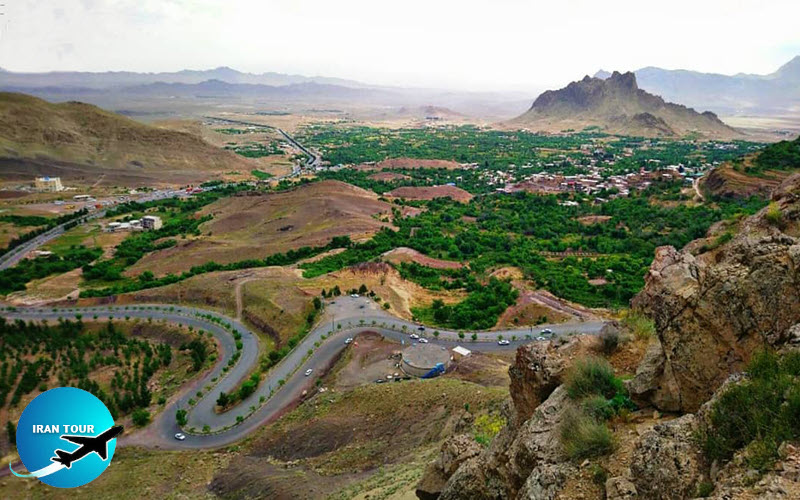 |
North-west of Kashan
Niasar
Your first destination is the beautiful green village of Niasar, 32 km northwest of Kashan. This historic village with a collection of historical and natural monuments will bring you an attractive excursion. A Sassanid fire temple, a handmade cave, a beautiful waterfall, a historic bath - a historic mill, and rose-making workshops are a collection of the best sights in this area.
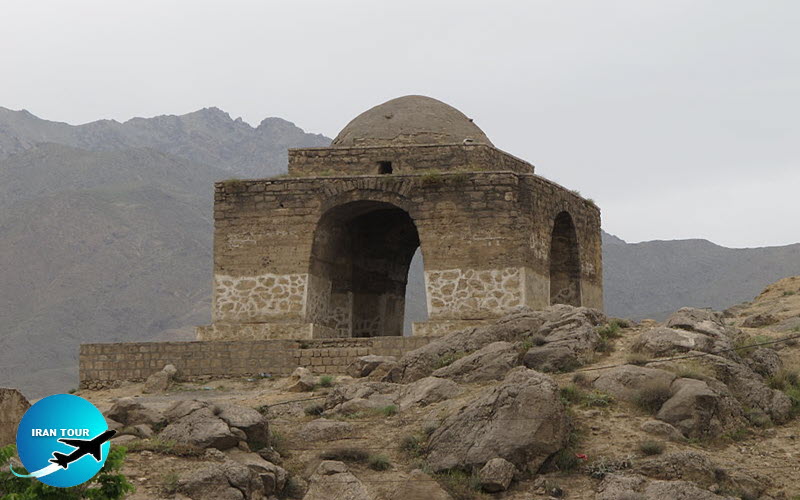 |
Fire Temple
The Sassanid Niasar Fire Temple known as Chahar Taghi or 4 Ivan is a domed structure on a rock on the highest hill in the village of Niasar. It is believed to have been built during the reign of Ardashir I, AD 224-242, although this date is uncertain. The structure takes the form of a Chahar-Taq, or a cube with an arched opening on each side, topped by a dome. Its original function was to hold a sacred fire, and it would have been used as a beacon for travelers and as a center for religious ceremonies. The building has been extensively restored. Generally, there would be a number of other facilities around the fire temples where Zoroastrian monks gathered to worship. Although it is not known if this building was used for this purpose, there are rows of stones placed together near the fire temple that are remains of a building belonging to the Sassanid era.
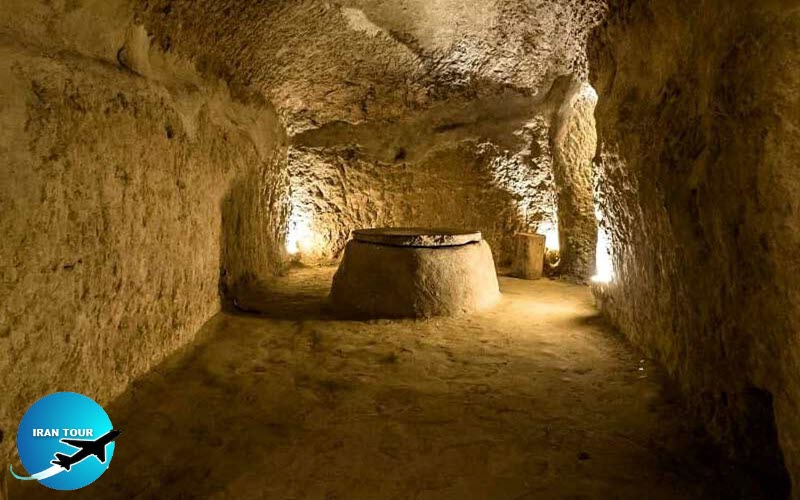 |
Niasar Cave
It is known as the cave or Talar cave or Surakh Reis close to the Niasar Fire temple. The Niasar cave is a Mitra temple and thoroughly man-made which dates back to the Parthian era. Some also believe that this cave was a defensive factor against the enemies and hiding from local thieves.
Old Bath
This is one of the public charity buildings from the Safavid era. The architecture of this bathroom and the transformation of water into the bath is very exciting and intelligent. The water is transferred from the Niasar waterfall and carry into an octagonal area and then to the bathroom and then transferred to the full bathroom.
Watermill
This watermill belongs to the Safavid period. The water required for this mill is supplied by special mud pipes from the Niasar waterfall. There are some of these mills in Niasar that are out of service.
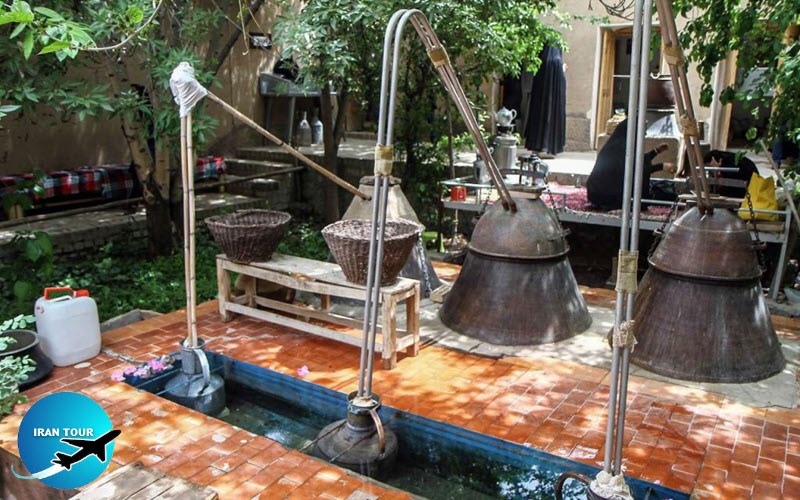 |
Rose Water Festival
One of the most famous Iran natural events is the Rose Water Festiva in Kashan and its suburbs. Kashan Rose Water Festival is held each May, hosted by Qamsar and Niasar. The most famous area for this event is Qamsar city with its famous rose water. Also, the Niasar city is one of the main cities of Kashan that do this ceremony as well as Qamsar. You can watch the traditional workshops all over the city. Their rosewater is truly reputed in the world and in terms of quality, it is absolutely unrivaled.
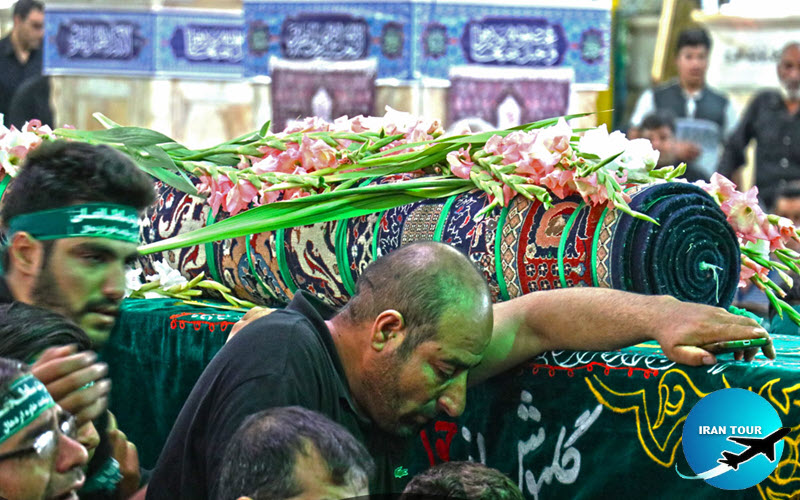 |
Qalischuyan rituals of Mašhad-e Ardehāl
Your next destination to the northwest of Niasar is Mashhad e Ardehal city. Mashhad-e Ardehal is a pleasant summer village in the foothills of the Ardehal mountains, about 40 km west of the town of Kashan and 22 Km from Niasar. The village is mainly identified with its famous historical and spiritual heritage, namely the mausoleum of Sultan Ali ibn Mohammad and the Qali Shuyan ceremony. In fact, the word “Mashhad” (meaning the place of martyrdom) alludes to the martyrdom of Sultan Ali here in Ardehal.
Qalischuyan rituals are performed in Iran to honor the memory of Soltān Ali, a holy figure among the peoples of Kashan and Fin. According to legend, he was martyred and his body was found and carried in a carpet to a stream, where it was washed and buried by the inhabitants of Fin and Xāve. Today, the Soltān Ali Mausoleum is the site of a ritual where a carpet is washed in the sacred stream by a huge gathering.
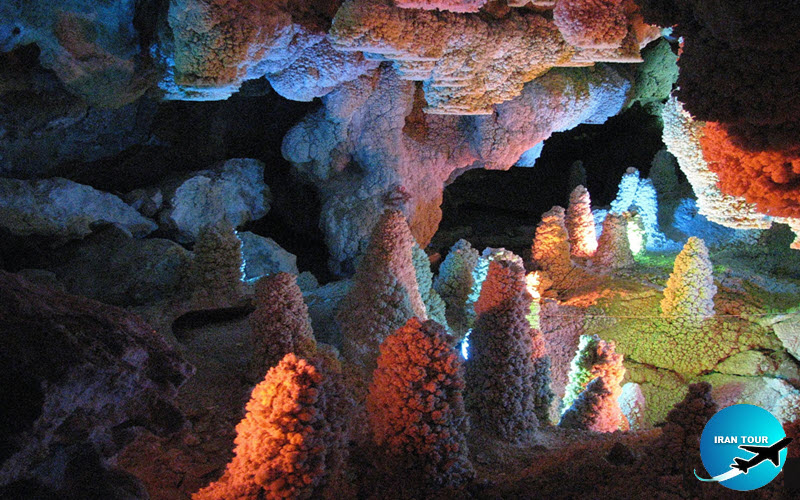 |
Chal Nakhjir Cave
if you are a nature lover and love to visit a cave that dates back to the third geologic period Chal Nakhjir Cave is calling you. Just 35 Km far from Mashhad Ardehal the Chal Nakhjir Cave with its unique and fantastic beauties host different tourists annually. Over millions of years, the movement of the faults caused the creation of corridors and fabulous ponds in the Chal-Nakhjir cave which made the important features of this cave. In addition, the Chal-Nakhjir cave is a living cave. This means that if any part of this cave is destroyed, it will be restored over the years. More than 2000 meters of dry spaces have been identified inside this cave as these spaces generally crystallized. The crystalline and spongy ornamentation of the floor, walls, and ceiling is the best specimen in the world. According to the opinion of the
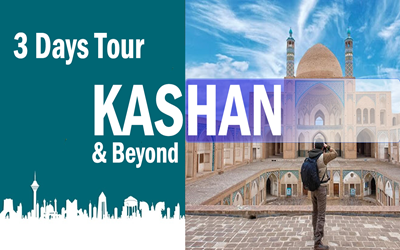 |
geologist, the length of the cave is estimated at about 12 kilometers, of which only six kilometers have been discovered so far. The air temperature inside the cave, similar to other caves in all seasons is between 7 ° C and 14 ° C.
Different levels in Chal-Nakhjir cave
Two floors of this spectacular cave have been prepared for visitors. You can follow the path that takes you to visit Chal-Nakhjir cave. The Chal-Nakhjir cave consists of three levels as follows:
-The first level includes aquifers and a lake located at a depth of 61 meters below the level of the cave. The minimum and maximum depth of this lake is 10 to 70 meters.
-The second level is a path that starts from the entrance of the cave and continues up to 900 meters.
-The third level starts 900 meters from the main path and continues up to 3000 meters.
 |
North-est of Kashan
If you are a nature lover and a lover of desert trips, this excursion is designed for you. If you are going to lie on the warm and golden sands of the desert, hear the sound of the wind blowing through the sands, walk on the sands, and see the night sky of the desert with millions of stars, this will be your best choice. Be assured that this part of your trip will have the most exciting and beautiful moments. This desert tour will provide you with a collection of historical, cultural, architectural, and natural monuments of Iran in the best way.
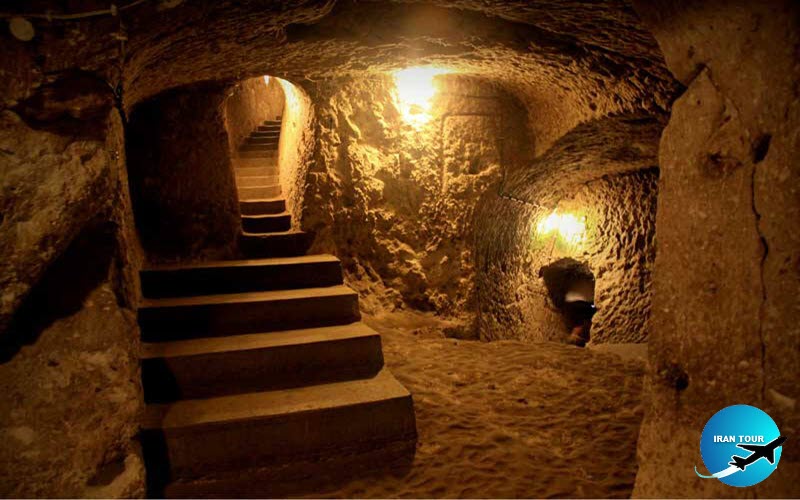 |
The Underground City of Nushabad
The Underground City of Nushabad (or Nooshabad or Noushabad) is located about 13 kilometers north of Kashan. It is well-known for its underground man-made city. It is called Ouee (or Ouyi), which had been used as a shelter by the desert inhabitants against invasions and attacks. It is dug up 4 floors underground about 1500 years ago during the Sassanid and pre-Islamic periods. It was still in use during the Seljuk and Safavid periods until the Qajar era. It is made of different labyrinths, corridors, chambers, and wells. The vertical channels connect the different floors to each other. The height of entrances (except the main one) is 170-180 centimeters (nearly the same as normal human height). It’s the largest underground city in the world with an area of 4 square kilometers in the depth of 4 to 18 meters. It is registered on the Iran National Heritage list.
The other historical sites of Noushabad are:
-Sizan Castle a mud-brick fortification, with 9 towers, dates back to the Seljuk period and is registered on the Iran National Heritage list.
-The 20 qanats, parallel to each other, located about 15 kilometers north of Nushabad.
-Atiq Jame Mosque said to be a fire temple before Islam, registered on Iran National Heritage list.
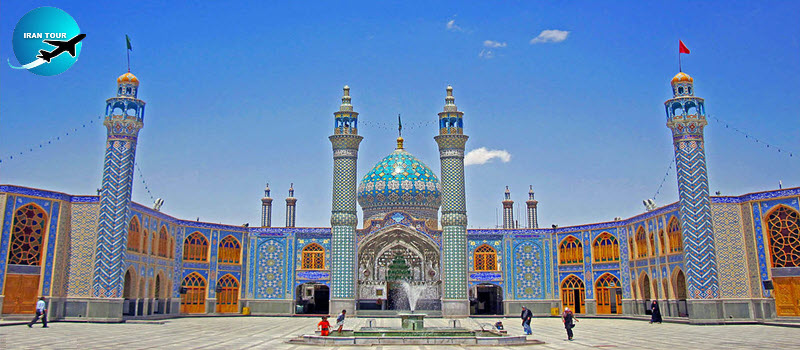 |
Aran and Bidgol city
The city of Aran and Bidgol has located 5 km from the city of Noshabad. This city is considered the gate of the desert and is your last city before entering the beautiful desert of Maranjab. The unique and fantastic attractions of this region such as the Maranjab Desert, Maranjab Caravanserai, Salt Lake, sand dunes, and desert plants attract many tourists to this region.
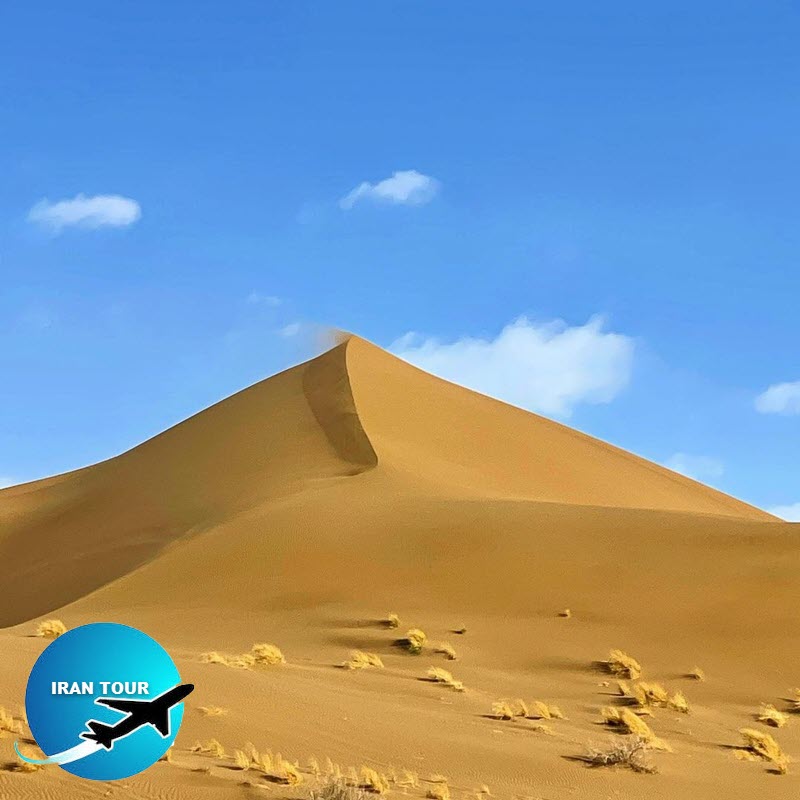 |
Maranjab Desert
The Maranjab Desert with different vegetation like halophyte plants such as Tamarix trees, Haloxylon trees, and Zygophyllum shrubs and animal covers like the wolf, jackal, hyena, sand fox, sand cat, lizard, chameleon, a variety of lizards, snakes, scorpions, yellow partridge dull, eagle, the hawk is one of the best Iran's desert that is recommended to all off-road lovers.
Things to do and see
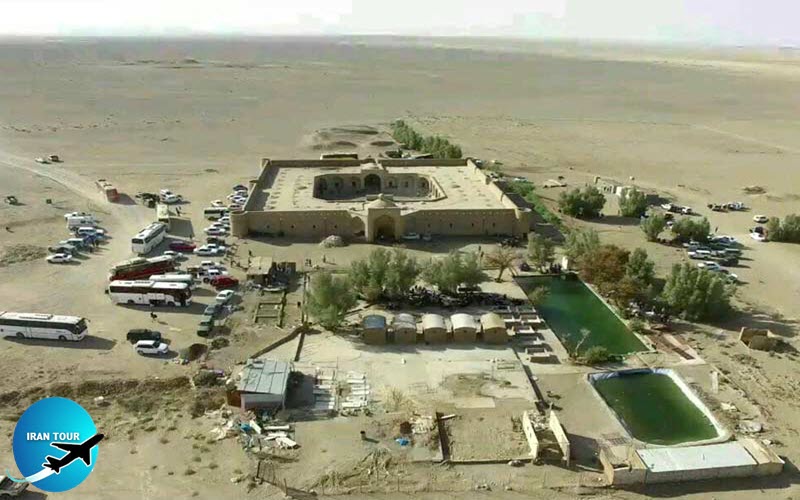 |
Maranjab Caravanserai
Maranjab Caravanserai is one of the main Safavid caravanserais on the way Silk Road. It is made by the order of Shah Abbas the Great. Maranjab Caravanserai has a Qanat having fresh water which, is a phenomenon in a desert full of salt lakes. Today Maranjab caravanserai is used as a guest house with 29 rooms and accommodates tourists visiting this wonderful dessert. The around of Maranjab Caravanserai is safe and is a great place for camping.
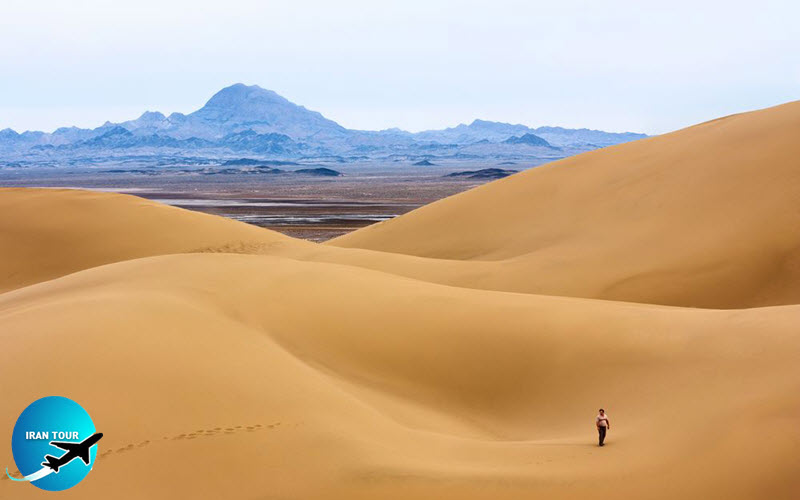 |
Sand dunes
The sand dunes of the Maranjab Desert are so interesting and wonderful that no one will miss them. If you are looking for a bit of adventure, with a 15-minute walk you can reach the top of the hills at 70 meters height, the view of the desert from the top is breathtaking. You can walk barefoot on the sand dunes and smell the desert sands. As the temperature rises in the desert at midday, it is best to walk on the moving sand dunes in the early morning or late afternoon.
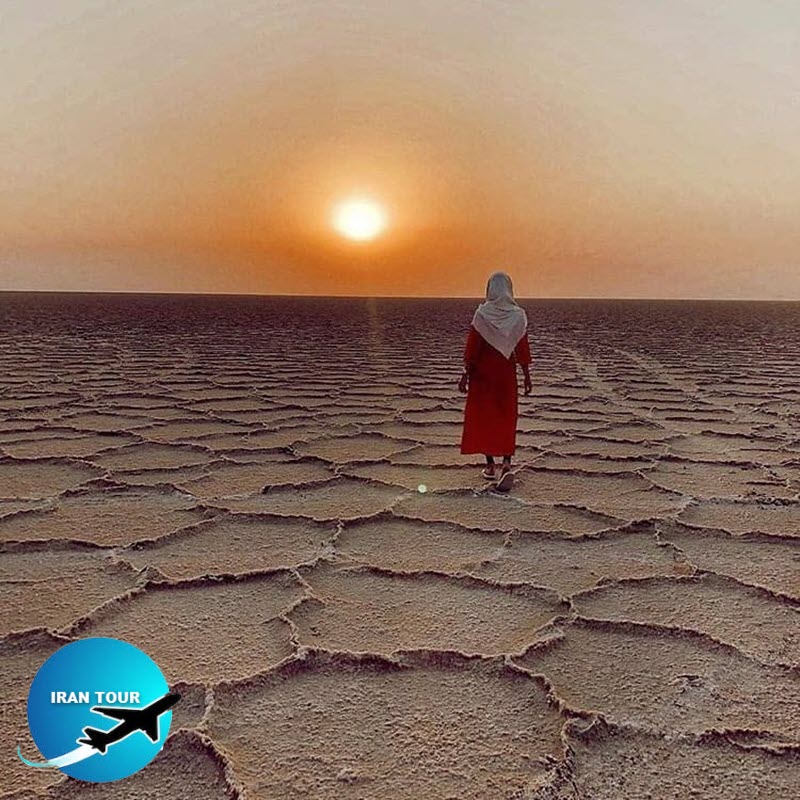 |
Maranjab salt lake
The salt lake of Maranjab with 1800 km² is another natural attraction of the Maranjab desert which is located about 100 km east of the city of Qom and 60 km from Kashan. The lake looks like a triangle and is 5 to 50 meters deep. The lands around the salt lake are swampy, so it is best to visit the salt lake with a local guide who knows the area. Generally, there are two ways to get to the Maranjab Desert:
-On the way from Aran to Maranjab, after driving about 35 km, you will see the path through the salt lake.
-Passing the Maranjab caravanserai, after 10 km you can see the road to the salt lake.
If you are lucky you may also see flamingos. September, October, and November (all fall) is the migration period for flamingos.
South of Kashan
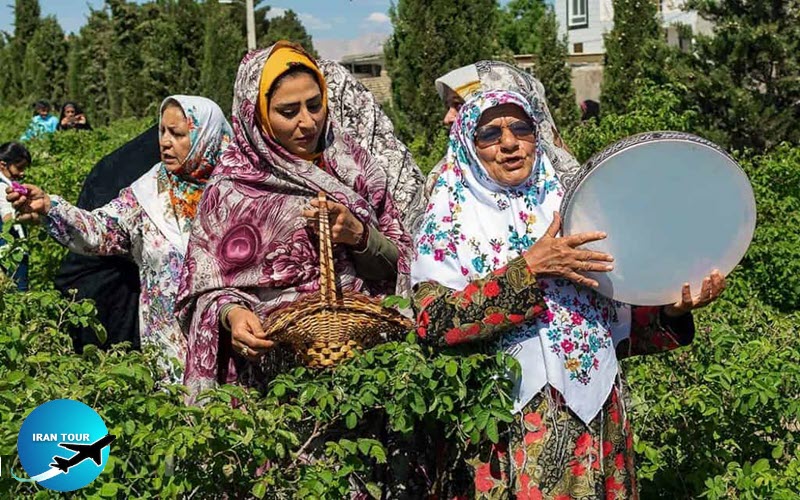 |
Qamsar, the capital of Iran Rosewater
Ghamsar, the city of flowers and roses, attracts countless domestic and foreign tourists every year with its pleasant spring and the air full of the fragrance of Damask roses. Everyone knows Ghamsar for its Damask roses and herbal essences. This city, which is located 41 km south of Kashan, becomes an earthly paradise in spring and especially in May Because when you travel to this city at this time, the whole city is a garden of Damask flowers. Ghamsar rose perfume is one of the export products of this country to European countries.
-Everything about the Rose and Rose Water Festival
The making of rose water is practiced in towns such as Qamsar, Niasar, Kamo, Vadeqan, and Barzak in Kashan. Although in most of the surrounding villages of Kashan, Mohammadi roses are planted and harvested, but rose water production is not possible in all areas. Flowers are therefore sent to workshops in other cities.
They pick the flowers up in the early morning before sunrise, Based on an old farmer myth, these flowers are richer with stronger scents.
Making rose water is done in different styles, but what tourists see in Qamsar and Niasar is the same traditional method by newer equipment.
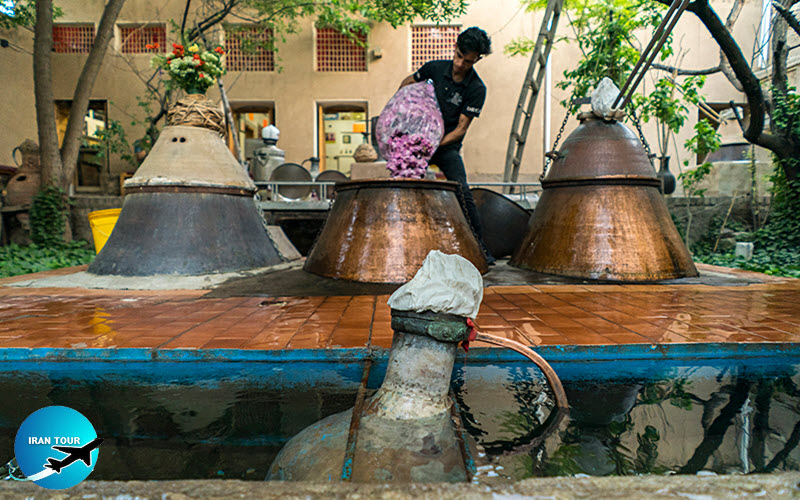 |
-When is the Rosewater Festival?
Kashan is one of the most important tourist destinations in Iran in spring, especially in May (Ordibehesht), due to the rose water festival in Kashan's suburbs.
This colorful and gorgeous event begins May 10 and continues through May 25.
-The traditional ritual ceremony in the rosewater festival
The ceremony used to take place according to certain customs and traditions. They collect the flowers from the garden and bring a large mass of flowers into the workshop while they sing traditional songs.
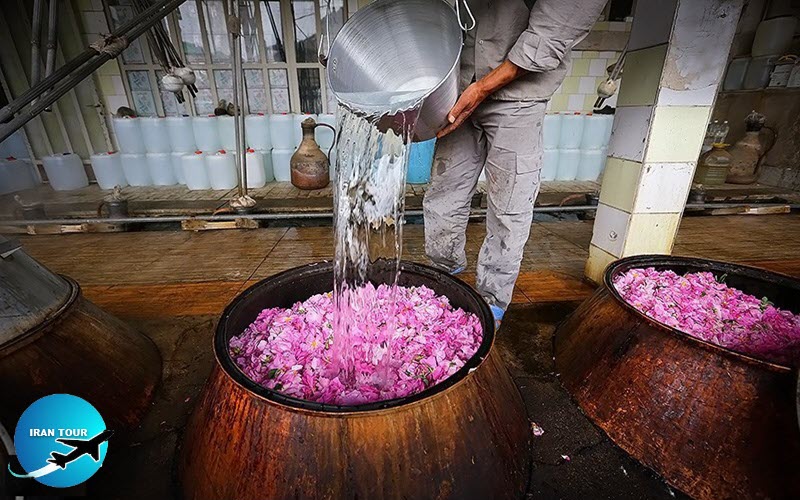 |
-The different parts of the ceremony
First, they put big steam boilers on ovens. They mix the flowers with freshwater (1kilo flower- 3 liters of water). The lid of the boilers closes completely (to prevent steam from escaping) and the water starts to boiling. The steam inside the boiler transfers through copper pipes to the copper pots in the water and makes it cool.
Of course, before the ceremony begins, they usually take the pot and the flowers along the rivers and say religious prayers. The packs, depending on their capacity, provide around 30 to 40 litters of rose water. If you want to have very special rose water then you have to re-boil the rose water in the boilers. Tourists from all over Iran and the world come to this city during the Rosewater Festival in Kashan to witness this beautiful process.
Also, Farmers plant a variety of medicinal plants and obtain herbal medicines from them.
- Details
- Category: KASHAN TOURISM